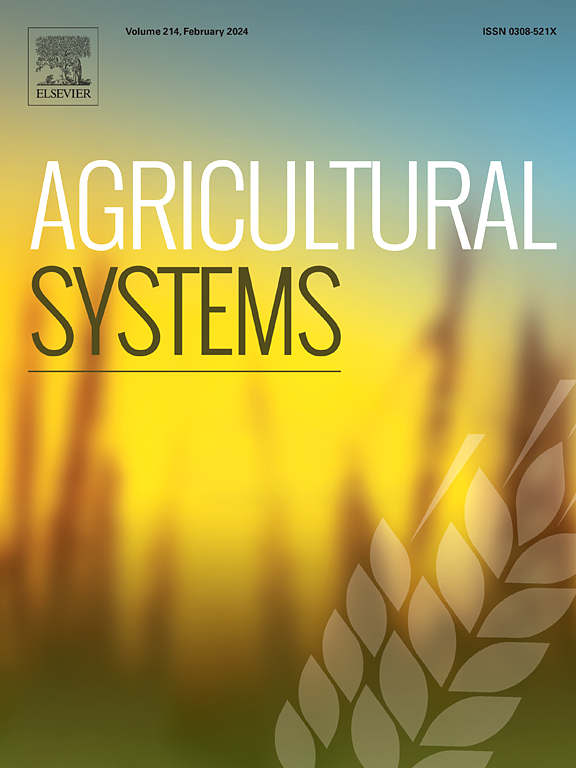IF 6.1
1区 农林科学
Q1 AGRICULTURE, MULTIDISCIPLINARY
引用次数: 0
摘要
背景欧洲的农业系统依赖进口合成肥料和饲料。在全球石油峰值和地缘政治危机的背景下,重要的是要不断提高投入品进口的独立性,并减少其对环境的影响。这就需要更好地整合作物和牲畜,特别是在地区层面。研究的目的是在地区层面探讨作物-牲畜的变化如何保持或最大限度地提高农业产量,并在减少氮进口的同时影响氮的使用效率。研究对象是法国三个不同作物-牲畜组成的农业系统:大田作物(皮卡尔高原)、集约化奶牛和单一畜牧业(中央布列塔尼省)以及粗放型反刍动物(布尔邦纳河谷)。方法将进化遗传算法的两种多目标优化方案应用于农业系统氮平衡模型。这些方案反映了两种施肥策略:(i) 使用合成肥料保持目标作物产量;或 (ii) 根据可用的天然肥料和有机肥料调整作物产量。决策变量为作物种植面积类型和牲畜密度,它们在一系列农艺限制条件下系统地变化。结果与结论 在布尔邦纳河谷,无论采用哪种策略,在不进口氮的情况下,畜牧业产量和农作物产量都会增加(总计达到 +24 千克氮/公顷利用农业耕地(UAA)/年),特别是通过增加畜群中单胃动物的比例(第一种策略的中位数为 +25%)。在这些产量最高的情况下,氮浪费最多可减少 12.5 千克氮/公顷利用农业耕地面积/年。在其他耕作制度中,只有在不进口氮的情况下,才有可能提高农业产量(不利于作物或畜牧业生产)(皮卡尔高原总计+2千克氮/公顷UAAA/年,布列塔尼中央省+5千克氮/公顷UAAA/年)。然而,只有布列塔尼中央省的氮浪费有所减少(-70 千克氮/公顷欧亚大气年),畜牧业产量急剧下降(∼100%)。这三个地区的产量增长表明,豆科植物的共生固定作用高达 150 千克氮/公顷耕地/年。这些结果表明,要大幅减少氮进口,就必须重新考虑牲畜在农业生产中的地位,并降低目标作物产量。本文章由计算机程序翻译,如有差异,请以英文原文为准。

Exploring optimised crop-livestock changes that promote higher efficiency and reduced N imports in three French farming systems
CONTEXT
European farming systems depend on synthetic fertilisers and feed imports. In a context of global peak oil and geopolitical crises, it is important to seek increasing independence from input imports and to reduce their environmental impact. This requires better crop-livestock integration, notably at the territorial level. However, this implies contending with the trade-offs related to agricultural production.
OBJECTIVE
The study aim was to explore, at the territorial level, how crop-livestock change can maintain or maximise agricultural production and affect N use efficiency while reducing N imports. This was investigated in three French farming systems characterised by different crop-livestock compositions: field crops (Plateau Picard), intensive dairy cattle and monogastrics (Bretagne Centrale) and extensive ruminants (Bocage Bourbonnais).
METHODS
Two multi-objective optimisation scenarios using an evolutionary genetic algorithm were applied to a farming system N balance model. These scenarios reflected two fertilisation strategies: (i) maintaining target crop yields with synthetic fertiliser or (ii) adapting crop yields to available natural and organic fertiliser. The decision variables were types of crop acreage and livestock density, which were systematically varied within a set of agronomic constraints. The optimised objectives were maximisation of crop and livestock production and minimisation of synthetic fertiliser use and imported feed.
RESULTS AND CONCLUSIONS
In Bocage Bourbonnais, no matter which strategy was used, both livestock production and crop production with no N imports increased (up to a total of +24 kgN/ha utilised agricultural acreage (UAA)/yr), in particular by increasing the proportion of monogastrics in the herd (median, +25 % with the first strategy). For these production maximums, N waste fell by up to 12.5 kgN/haUAA/yr. In the other farming systems, it was only possible to increase agricultural production (to the detriment of either crop or livestock production) without N imports (a total of +2 kgN/haUAA/yr for Plateau Picard and + 5 kgN/haUAA/yr for Bretagne Centrale). However, N waste decreased only in Bretagne Centrale (−70 kgN/haUAA/yr), with a sharp drop in livestock production (∼100 %). These production increases for the three regions showed up to 150 kgN/ha arable land/yr of symbiotic fixation by legumes.
SIGNIFICANCE
For three different farming systems at the territorial level, the results quantified the extent to which crop-livestock changes can lead to greater independence from imported inputs and reduce N waste while maintaining or increasing agricultural production. These results imply that a substantial reduction in N imports will require reconsidering the livestock place in agricultural production and reducing target crop yields.
求助全文
通过发布文献求助,成功后即可免费获取论文全文。
去求助
来源期刊

Agricultural Systems
农林科学-农业综合
CiteScore
13.30
自引率
7.60%
发文量
174
审稿时长
30 days
期刊介绍:
Agricultural Systems is an international journal that deals with interactions - among the components of agricultural systems, among hierarchical levels of agricultural systems, between agricultural and other land use systems, and between agricultural systems and their natural, social and economic environments.
The scope includes the development and application of systems analysis methodologies in the following areas:
Systems approaches in the sustainable intensification of agriculture; pathways for sustainable intensification; crop-livestock integration; farm-level resource allocation; quantification of benefits and trade-offs at farm to landscape levels; integrative, participatory and dynamic modelling approaches for qualitative and quantitative assessments of agricultural systems and decision making;
The interactions between agricultural and non-agricultural landscapes; the multiple services of agricultural systems; food security and the environment;
Global change and adaptation science; transformational adaptations as driven by changes in climate, policy, values and attitudes influencing the design of farming systems;
Development and application of farming systems design tools and methods for impact, scenario and case study analysis; managing the complexities of dynamic agricultural systems; innovation systems and multi stakeholder arrangements that support or promote change and (or) inform policy decisions.
 求助内容:
求助内容: 应助结果提醒方式:
应助结果提醒方式:


